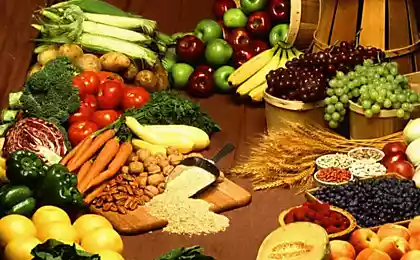430
8 best probiotics

In General, probiotics are a class of micro-organisms and substances, usually of microbial origin. It sounds a bit scary, but probiotics are now widely used for therapeutic purposes and as food and dietary supplements containing live microculture. It is believed that probiotics may be useful to the widest range of users, including those who are intensively involved in sports.
Varieties of probiotics
Probiotics-bacteria that are most often recommended for athletes, divided into Lactobacillus (lat. Lactobacillus) and bifidobacteria (lat. Bifidobacterium). Within this division, there is also many subspecies, and each has its own strains.
For example, a strain of Lactobacillus Shirota helps to strengthen the immune system and helps move food through the intestines. Bulgaricus and very useful for those whose bodies can not cope with the lactose contained in dairy products.
All varieties of probiotics can also be divided into two groups — dry and liquid.
To dry probiotics are lyophilized (dried) bacteria. They can be in the form of powder, capsules or tablets. Getting into our body, these bacteria come out of hibernation and begin to "work" a few hours later.
Liquid probiotics are microorganisms in their original, not subjected to lyophilization form. Such bacteria take action in the human body immediately. Being in a physiologically active state, such microorganisms absorb the nutrient medium in which they are, and as a result, there metabolites the products of metabolism of compounds necessary for our body.
To enhance the effect of liquid probiotics should be taken along with water soluble vitamins, micro - and macronutrients, amino acids, etc.
Probiotics can be found not only in the form of powders, capsules, tablets, yogurt and other dairy products. In shops a wide choice of useful pribiotikov in the form of granola, energy bars, juices and even chocolate.
The use of probiotics
The main aim of probiotics is the restoration of balance of microorganisms that inhabit the mucous membranes of man, that is, treatment and prevention of all kinds of dysbacterioses and associated diseases.
In particular, as evidenced by scientific clinical tests, the use of probiotics promotes:
— improve immunity;
— prevention of various infectious diseases;
— protect the intestinal walls from harmful bacteria;
— strengthening of the mucus layer in the intestine;
— destruction and removal of toxins;
— to prevent the development of dysbacteriosis on the background of antibacterial therapy;
— synthesis of vitamin B1, B2, B5, B6, B12, PP, K, C, H;
— absorption of vitamins D, E, micro - and macroelements (iron, calcium, iodine, selenium, etc.);
— the digestion and absorption of up to 80-90% of proteins and carbs entering our body with food;
— the production of acetic, lactic, formic, propionic and butyric acids, which promotes synthesis of ATP and creatinine, and accordingly, the accumulation and allocation of the necessary for our muscles energy.
Today, you can find the view that not until the end of the influence of probiotics on the human body, for example, with severely impaired immune system or diagnosed problems with the digestive system. However, scientists agree that for a healthy body, most probiotics are not only safe, but useful. And that, in practice proved the centuries-old mankind use such dairy products as yogurt, cheese and milk.
8 best probiotics
In addition to supplements, probiotics are contained in many products familiar to us.
1. Yogurt
Considered to be the best source of probiotics — lactobacilli and bifidobacteria, keeping a healthy balance in our intestines. Studies show that these probiotics can alleviate lactose intolerance in some people. They also can curb flatulence, diarrhea, and other digestive disorders. It is important to choose yogurt with live and active cultures.
2. Sauerkraut
Contains probiotics Leuconostoc, pediococcus and lactic acid bacteria, which improve digestion. It is important to choose unpasteurized sauerkraut — pasteurization, used to increase shelf life of products kills the beneficial bacteria.
3. Miso soup
Popular Japanese soup with seaweed, vegetables, fermented soy and tofu, resulting in a normal digestive system. Miso contains more than 160 strains of beneficial bacteria!
4 . Pickles
Should be pickled without vinegar! Best pickling cucumbers with sea salt, a solution of which in water promotes the growth of beneficial bacteria and therefore improve digestion.
5. Soft cheeses
Not all beneficial for digestion probiotics retain their properties during the passage through the digestive tract. However, strains of lactobacilli in some fermented soft cheeses, such as Gouda, such a journey is kept. Cheese can also act as carriers of probiotics, stimulating the immune system.
6. Yogurt
Contains proprietary strains of probiotic bacteria, as well as several useful varieties of yeast.
7. Bread made from sourdough
Contains lactic bacteria that benefit digestion.
8. Acidophilus milk
Is a low fat milk fermented with Lactobacillus acidophilus.
Note
It should be borne in mind that probiotics are considered a dietary Supplement and, therefore, unlike drugs, they are not standardized. Thus, depending on the manufacturer, they can vary greatly. Similarly, the very different may be their cost.
To avoid problems, choosing probiotics, carefully study their composition, to exclude the presence of additional components, which you can have an allergic reaction.
On the label, you are buying a probiotic, should be given information about the strains and species of probiotic microorganisms contained in the product, quantity, expiry date and storage method.
Probiotics and prebiotic
Unlike contain live bacteria probiotic products, prebiotic is a non-digestible food components that selectively stimulate the reproduction, growth, development and activity of one or more types of beneficial bacteria that live in the gastrointestinal tract. Prebiotiki, which are also very useful and necessary for the human body are contained in foods such as asparagus, bananas, oatmeal, red wine, honey, maple syrup and legumes. published
Source: fitfixed.com























